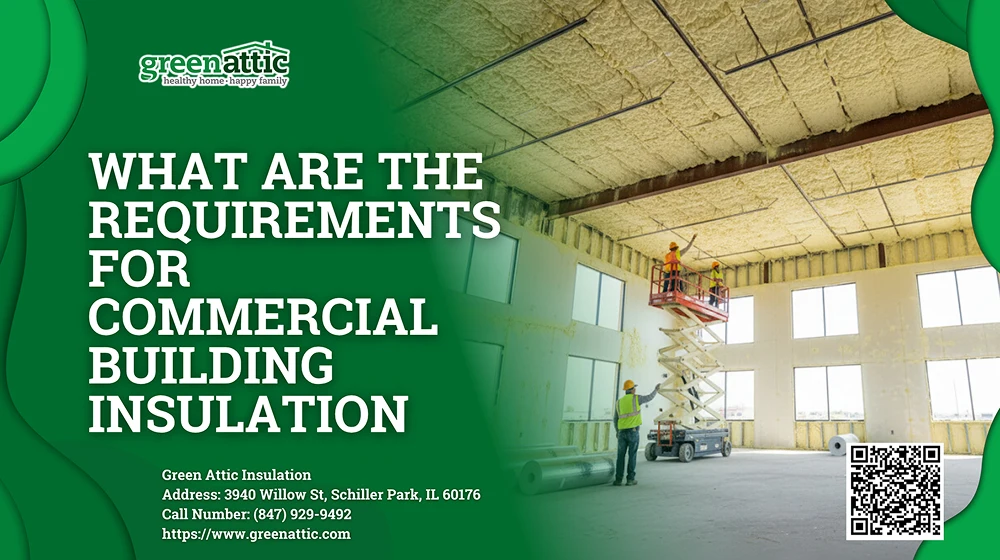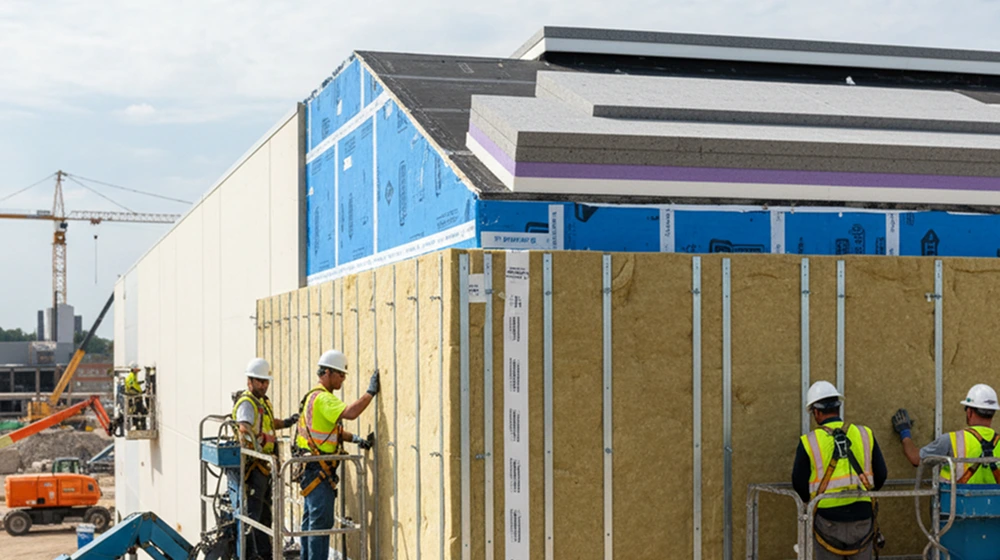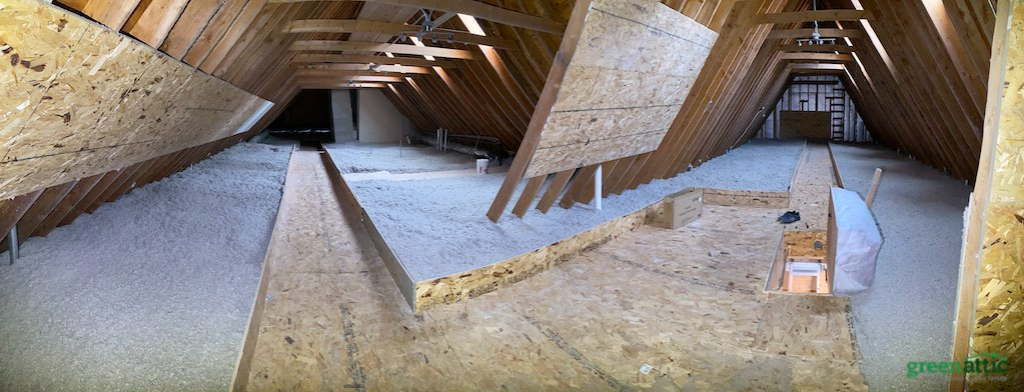Insulation in commercial buildings plays a powerful role in improving building performance and significantly reducing energy consumption.
From roof insulation to continuous insulation systems, selecting the right insulation not only enhances comfort but also ensures compliance with today’s energy and building regulations.
This article is a complete guide for contractors, architects, developers, and building owners looking to navigate the complex world of commercial building insulation requirements.
Whether it’s a brand-new commercial facility or a retrofit, factoring in insulation early supports better performance and smoother code approvals.
What Is Commercial Building Insulation and Why Does It Matter?

Commercial building insulation is a high-value system that resists heat flow across the envelope including walls, roofs, and floors, improving comfort, efficiency, and durability.
Proper insulation installed not only provides thermal and sound insulation but also plays a key role in energy efficiency and maintaining comfortable conditions for building occupants.
According to the 2018 International Energy Conservation Code (IECC), proper insulation levels are key to lowering energy use, saving money, and creating healthier, more comfortable space. Commercial insulation isn't just about saving money it's part of a building's duty to meet minimum efficiency requirements while protecting occupant health and the environment.
How Do Building Codes Define Insulation Requirements?
Local and international building codes provide clear guidance to help ensure insulation meets high standards for safety and efficiency. Codes establish clear benchmarks like R-values, helping builders select insulation that delivers strong thermal resistance and long-term comfort.
By specifying insulation types for each building component, codes simplify design decisions and ensure optimal energy efficiency across walls, roofs, and floors. Location-based codes encourage customized insulation solutions, ensuring each project is optimized for its climate and building type.
What Does the IECC Say About Insulation in Commercial Buildings?
The International Energy Conservation Code (IECC) provides comprehensive guidelines that help enhance energy efficiency in commercial buildings. By prioritizing continuous insulation across wall assemblies, the IECC supports improved thermal performance and reduced energy loss.
Some of the most beneficial IECC provisions include:
- Enhanced R-value requirements for walls, roofs, and floors to boost insulation effectiveness
- Empowers energy-smart roofing with above-deck insulation to enhance performance and eliminate heat loss
- Clear definitions for various insulation types and applications, such as foam insulation, mineral wool, and spray foam
By setting these standards, the IECC not only promotes the effective use of insulation products, but also plays a vital role in ensuring consistent, high-performance energy outcomes across all climate zones.
How Do Climate Zones Affect Insulation Standards?
The IECC’s climate zone guidelines are designed to help buildings perform at their best—no matter the region. These zones ensure that insulation strategies are tailored to local heating and cooling needs, promoting comfort, energy efficiency, and code compliance. US climate zones guide you toward the right insulation solutions for greater energy efficiency and long-term comfort.
For example:
- Colder US climate zones benefit from higher roof insulation R-values, helping retain heat and reduce energy use in winter.
- Warmer zones often favor reflective or rigid foam board insulation, promoting cooler interiors and improved energy savings.
By identifying your building’s location within the US climate zone map, you can confidently select insulation solutions that exceed code requirements, enhance comfort, and boost long-term performance.
What Types of Insulation Materials Are Used in Commercial Projects?

The right insulation material not only enhances building performance but also helps ensure compliance with commercial energy codes.
Popular materials include:
- Spray foam insulation: Excellent air seal and R-value.
- Mineral wool insulation: Fire-resistant and sound-dampening.
- Cellulose insulation: Eco-friendly and effective in enclosed spaces.
- Rigid foam board insulation: Ideal for continuous exterior use and commonly used in commercial metal building insulation systems.
- Blown-in insulation: Great for retrofits in existing buildings.
Each insulation type brings unique benefits, and applying it correctly within the building envelope ensures optimal performance and code compliance.
What’s the Difference Between Continuous and Layered Insulation?
Continuous insulation (CI) offers uninterrupted thermal coverage across all structural elements, preventing heat loss and improving overall building performance. Installed externally between the wall sheathing and cladding, it plays a key role in energy-smart construction.
A layer of insulation placed between framing members can effectively improve temperature stability and reduce energy use. This approach works well in many building designs and complements other insulation systems for improved performance.
- CI helps create tighter, more efficient building envelopes, ensuring compliance with IECC standards.
- Above-deck insulation is now a go-to solution for meeting today's rigorous energy codes.
How to Select the Right Insulation for Your Building Type
Choosing the right insulation can significantly enhance energy performance, comfort, and compliance and it starts with a few key factors:
- Type of building (e.g., warehouse, office, school)
- Climate zone and building location
- Budget and energy costs
- Local commercial building code insulation standards
In educational settings, thermal and acoustic insulation helps create focused, comfortable spaces.
Understanding how insulation is applied allows building professionals to boost performance, meet energy codes, and increase long-term value.
How Is Roof Insulation Handled in Building Code Compliance?
Roof insulation is a key focus of modern energy codes, thanks to its major role in reducing energy loss.
Under the IECC, placing insulation above the deck is now a standard practice, delivering improved efficiency, reduced condensation, and long-term durability.
Modern codes often call for:
- Minimum R-values based on zone
- Use of rigid foam board insulation
- Layering techniques to boost performance
Roofs present one of the greatest opportunities to reduce heat loss and improve building energy efficiency. Proper roof insulation dramatically improves building performance, especially in commercial buildings or portions with high occupancy or equipment loads.
Are There Special Rules for Existing Buildings?
Yes. Renovations can achieve strong energy performance while meeting commercial insulation codes. Existing buildings must meet minimum insulation requirements, and the code provides practical pathways to get there.
Adjustments are available to help you succeed with:
- Project scope to align upgrades with timelines and budgets
- Existing structure to ensure practical, code-compliant solutions
- Historic designation to protect heritage and enhance efficiency
When wall cavities are tight during a retrofit, exterior insulation options provide an effective path to upgrade performance. The goal is to still reduce energy consumption and improve comfort wherever possible.
What Are the Penalties for Not Meeting Insulation Requirements?
Complying with construction codes and standards offers building owners significant advantages:
- Smooth approval of permits and timely project progress
- Lower energy costs through efficient insulation and design
- Stronger, more reliable building performance
- Enhanced long-term property value
In addition, compliance supports favorable insurance terms and makes resale more attractive. By working with local professionals and following code requirements, owners can ensure safe, efficient, and future-proof buildings.
Key Takeaways: What You Need to Remember About Insulation for Commercial Buildings
- Insulation plays a key role in keeping your space energy-efficient, comfortable year-round, and up to code.
- The IECC establishes vital thermal performance benchmarks, helping commercial buildings of every type achieve greater efficiency and comfort.
- By minimizing thermal bridging, continuous insulation boosts efficiency and in many cases, it’s also a code requirement.
- Your building’s location and climate zone guide the R-values required, ensuring insulation that’s tailored to deliver comfort and efficiency year-round.
- From spray foam to mineral wool to foam board, using the right insulation material for your building type ensures lasting efficiency, comfort, and performance.
- Installing roof insulation entirely above the deck is a common requirement and a proven way to maximize energy efficiency and long-term comfort.
- While existing buildings must comply with applicable codes, allowances for structural limitations can offer flexibility in achieving efficiency and safety goals.
- By checking commercial construction regulations and insulation benchmarks before your project begins, you pave the way for a smoother process and peace of mind down the road.
- Meeting these insulation compliance thresholds safeguards your investment and enhances occupant safety.
In the end, choosing the proper insulation goes beyond best practice, it’s a legal obligation that protects both your building’s performance and your peace of mind.
About Green Attic Insulation
Green Attic Insulation is a trusted leader in energy-efficient solutions for residential and commercial buildings. With years of experience in the industry, we specialize in helping building owners, contractors, and developers meet and exceed insulation requirements set by the IECC and local building codes.
Whether you're insulating a new facility or retrofitting an existing building, our team offers high-performance insulation products, expert guidance, and code-compliant insulation solutions tailored to your specific building.
From commercial spray foam insulation to continuous insulation systems for industrial buildings, Green Attic Insulation is your partner in improving building energy performance, reducing energy consumption, and achieving long-term savings.















.svg)
.svg)
.svg)
.svg)
.svg)
.svg)
.svg)
.svg)
.svg)
.svg)
.svg)
.svg)
.svg)
.svg)

.svg)
.svg)
.svg)
.svg)
-1.svg)
.svg)
.svg)





![Best Pole Barn Insulation Options [Ultimate Guide 2024]](https://cdn.prod.website-files.com/64748b312a3cf2627374a8cb/676422da45335704ef3b7f61_Pole-Barn-Insulation-Guide-Enhancing-Comfort-and-Efficiency1.webp)
